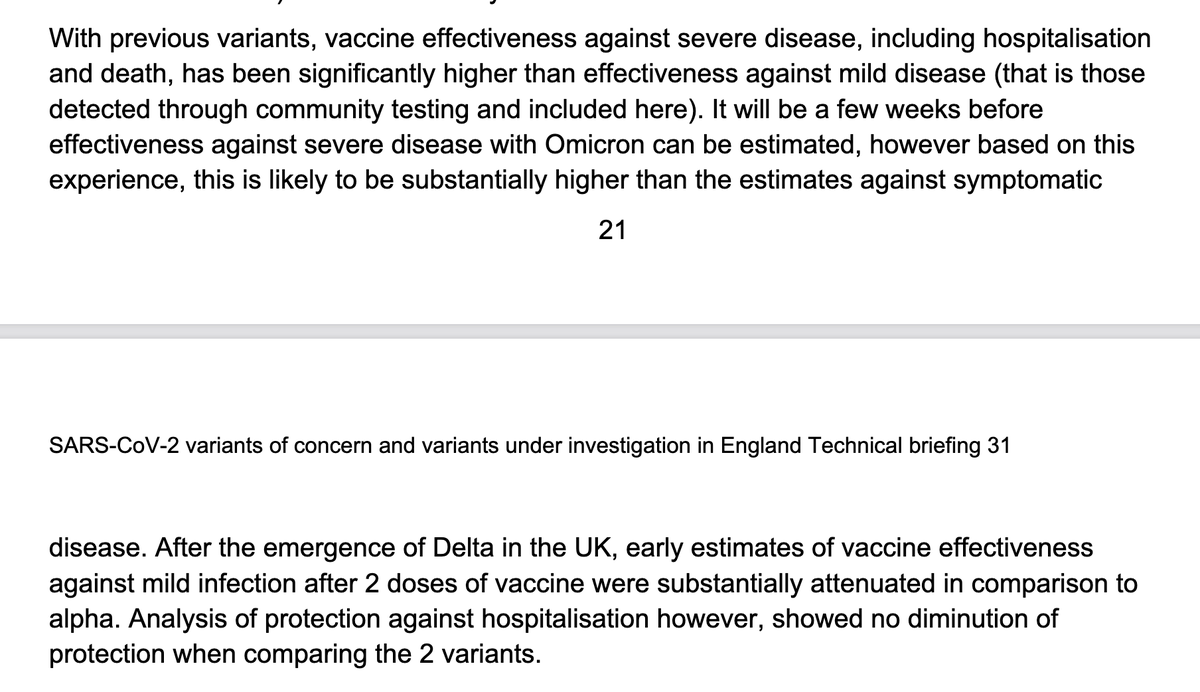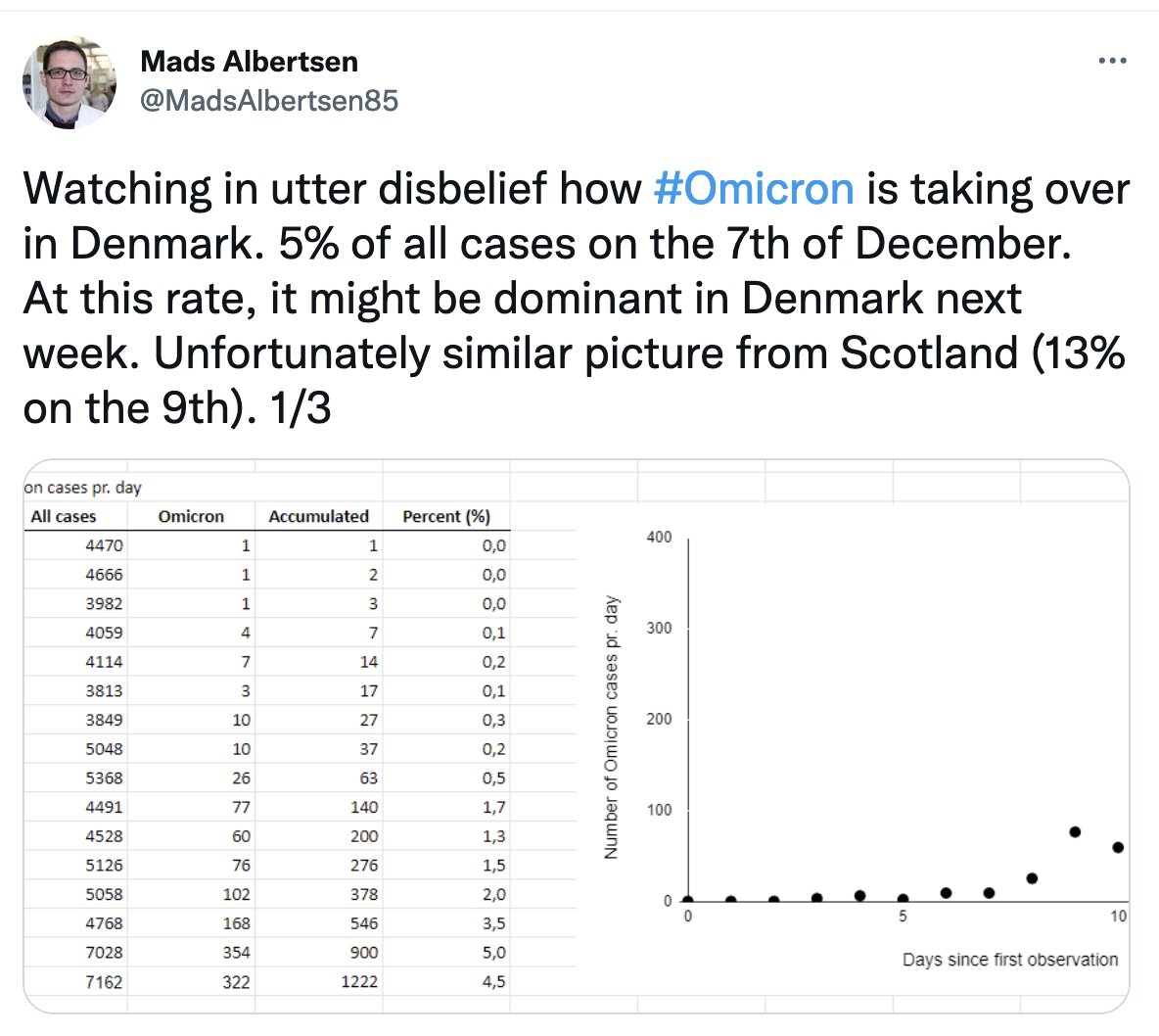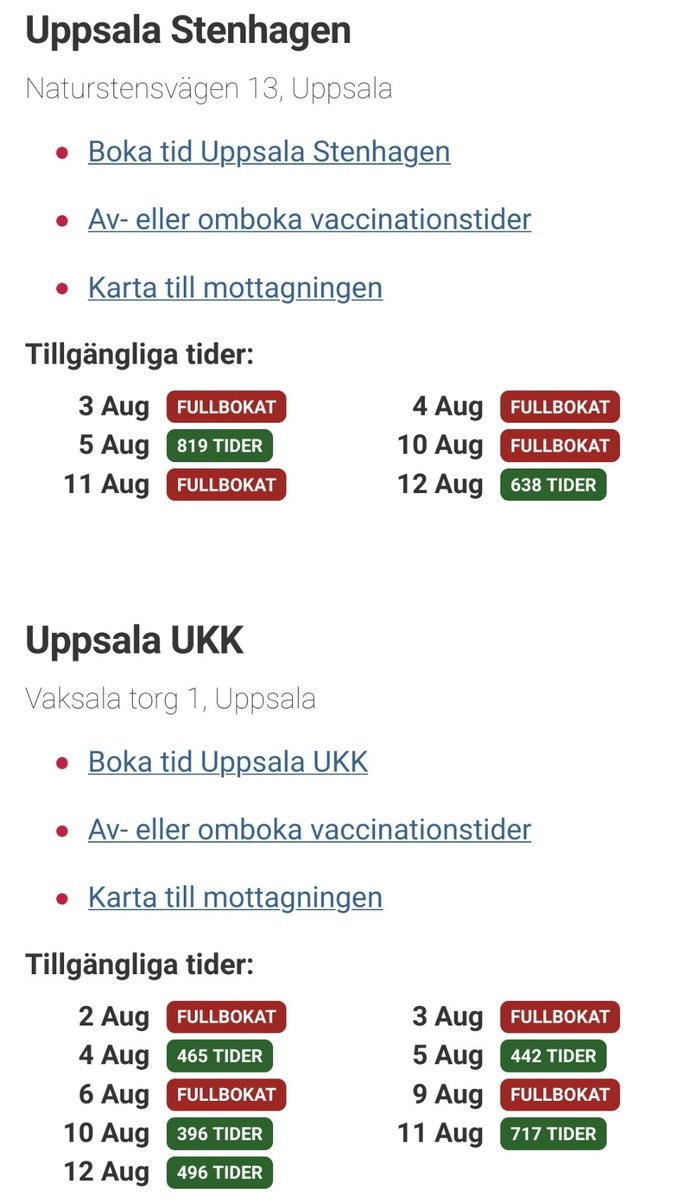
Bra & dåliga nyheter gällande #Omicron:
God nyhet:
⦿ Preliminärt ger 3 vaccindoser ~70-75% skydd mot symptomatisk #COVID19 orsakad av Omicron
- åtminstone ~2 veckor efter dos 3 & hos yngre
Därmed antas vaccinskyddet mot svår C19 vara än högre
Trista nyheter-> 🧵

God nyhet:
⦿ Preliminärt ger 3 vaccindoser ~70-75% skydd mot symptomatisk #COVID19 orsakad av Omicron
- åtminstone ~2 veckor efter dos 3 & hos yngre
Därmed antas vaccinskyddet mot svår C19 vara än högre
Trista nyheter-> 🧵


2/ Trista nyheter:
I jämförelse med smittsamma Delta tycks Omicron, *preliminärt*:
⬆️ Reinfektionsrisken 5x (3.4-7.8x) för de med tidigare COVID-19
⬆️ ~2 ggr oddsratio att föra smittan vidare till nära kontakter
⬆️ ~3 ggr oddsratio att föra smittan vidare till hushållskontakter
I jämförelse med smittsamma Delta tycks Omicron, *preliminärt*:
⬆️ Reinfektionsrisken 5x (3.4-7.8x) för de med tidigare COVID-19
⬆️ ~2 ggr oddsratio att föra smittan vidare till nära kontakter
⬆️ ~3 ggr oddsratio att föra smittan vidare till hushållskontakter
3/ Trista nyheter:
*preliminära*
⦿ ~22% kontra tidigare 11% risk att en hushållskontakt smittas (secondary attack rate; SAR)
⦿ Smittan växer nu med dubblering var 2.5:e dag i Storbritannien – beräknas kunna ta över (dvs. majoritet av fallen) om någon vecka i Storbritannien.
*preliminära*
⦿ ~22% kontra tidigare 11% risk att en hushållskontakt smittas (secondary attack rate; SAR)
⦿ Smittan växer nu med dubblering var 2.5:e dag i Storbritannien – beräknas kunna ta över (dvs. majoritet av fallen) om någon vecka i Storbritannien.

4/ Trista nyheter (preliminära):
2 vaccindoser tycks inte ge särskilt bra skydd mot symptomatisk Omicron-C19:
I figuren, notera att 0% ligger i mitten
(De delvis negativa intervallen överlappar varandra så kan ej tolkas som sämre vid tidigare veckor)
assets.publishing.service.gov.uk/government/upl…
2 vaccindoser tycks inte ge särskilt bra skydd mot symptomatisk Omicron-C19:
I figuren, notera att 0% ligger i mitten
(De delvis negativa intervallen överlappar varandra så kan ej tolkas som sämre vid tidigare veckor)
assets.publishing.service.gov.uk/government/upl…

5/ Med andra ord, utifrån ovanstående data riskerar många att smittas av infektionen & få symptomatisk COVID-19 av Omicron, tills fler får 3:e dosen eller en ny vaccinversion.
Dansk text om detta H/T, @AnnetteBruchfe1: dr.dk/nyheder/indlan…
Dansk text om detta H/T, @AnnetteBruchfe1: dr.dk/nyheder/indlan…
6/ Omicron kan snart dominera i Danmark & Skottland:
Och allt mer data från andra länder stödjer att de med tidigare COVID-19 liksom 2-3-dosvaccinerade också ofta drabbas: reuters.com/world/us/most-…



https://twitter.com/MadsAlbertsen85/status/1469331924447600652
https://twitter.com/kallmemeg/status/1469312352944283655?s=20
Och allt mer data från andra länder stödjer att de med tidigare COVID-19 liksom 2-3-dosvaccinerade också ofta drabbas: reuters.com/world/us/most-…
https://twitter.com/JCedernaes/status/1469225605589868551?s=20



7/ Pga snabb spridning & ⬆️ fallen, pekar den skottska analysen på att Omicron sannolikt kan belasta sjukvården mkt framöver:
Bara om Omicron är betydligt ⬇️ virulent än Delta – tex. via ett nu troligt hyfsat vaccinskydd mot svår C19 – kan detta lindras gov.scot/binaries/conte…
Bara om Omicron är betydligt ⬇️ virulent än Delta – tex. via ett nu troligt hyfsat vaccinskydd mot svår C19 – kan detta lindras gov.scot/binaries/conte…

8/ Ytterligare preliminär data som tyder på ökad reinfektionsrisk: medrxiv.org/content/10.110…
Samtidigt god nyhet att T-cellssvaret tycks vara intakt mot Omicron,
Samtidigt god nyhet att T-cellssvaret tycks vara intakt mot Omicron,
https://twitter.com/BogochIsaac/status/1469291236695674890, trots att neutraliseringen (via antikroppar) är mycket låg efter tidigare C19 eller 2 doser->

9/ Mer om den vaccininducerade, antikroppsbaserade neutraliseringen av Omicron jämfört med t.ex. Delta (dvs. hur väl neutraliseras Omicron av vaccinantikroppar – viktiga för skydd mot infektion i sig):
Sammanfattad i längre post:
facebook.com/jonathan.ceder…
https://twitter.com/JCedernaes/status/1468721274520276995?s=20
Sammanfattad i längre post:
facebook.com/jonathan.ceder…

10/ Med tanke på ovanstående risker, pekade ECDC nyligen på vikten av specifika åtgärder – t.ex. ökad sekvensering av infektioner & munskydd – med tanke på riskerna med Omicronvarianten
Men även Delta är ett pågående problem:
https://twitter.com/JCedernaes/status/1466397497006477317?s=20
Men även Delta är ett pågående problem:
https://twitter.com/ECDC_EU/status/1469328553313456130?s=20
11/ Utifrån vaccindatan & ⬆️ reinfektionsrisken (stämmer med:  ) kan många drabbas av Omicron vid bred samhällsspridning:
) kan många drabbas av Omicron vid bred samhällsspridning:
Men en 3:e dos ⬆️ skyddet mot Omicron.
Viktigt då att ⬆️ vaccinering – även vid tidigare COVID19 – se ECDC
 ) kan många drabbas av Omicron vid bred samhällsspridning:
) kan många drabbas av Omicron vid bred samhällsspridning:Men en 3:e dos ⬆️ skyddet mot Omicron.
Viktigt då att ⬆️ vaccinering – även vid tidigare COVID19 – se ECDC
https://twitter.com/JCedernaes/status/1466397490949890051?s=20

12/ För den som vill läsa en sammanfattning om den nya rapporten om beräknad vaccineffekt, transmissionsrisk, tillväxt av #Omicron och reinfektionsrisk (från UK Health Security Agency), finns den sammanfattad här:
facebook.com/jonathan.ceder…

facebook.com/jonathan.ceder…


13/ Förtydligande för denna bild (ej helt enkel att tolka) i tweet 4:
De delvis negativa intervallen *för beräkningarna för 2 doser* överlappar varandra, så kan ej tolkas som sämre vid tidigare veckor *för AstraZeneca* (AZ)
– och de pekar på bias i vilka som fått just AZ
De delvis negativa intervallen *för beräkningarna för 2 doser* överlappar varandra, så kan ej tolkas som sämre vid tidigare veckor *för AstraZeneca* (AZ)
– och de pekar på bias i vilka som fått just AZ

13.2/ Sen stavas det "skotska"...
Länken som saknas i tweet 11 (bildreferensen), för reinfektioner är denna neutralisationsdata:
Visar hur antikroppar från bl.a. de med tidigare alpha-, beta- & delta-SARSCoV2-infektioner *knappt* kan neutralisera Omicron
Länken som saknas i tweet 11 (bildreferensen), för reinfektioner är denna neutralisationsdata:
Visar hur antikroppar från bl.a. de med tidigare alpha-, beta- & delta-SARSCoV2-infektioner *knappt* kan neutralisera Omicron
https://twitter.com/JanineKimpel/status/1468700628922904591
• • •
Missing some Tweet in this thread? You can try to
force a refresh









